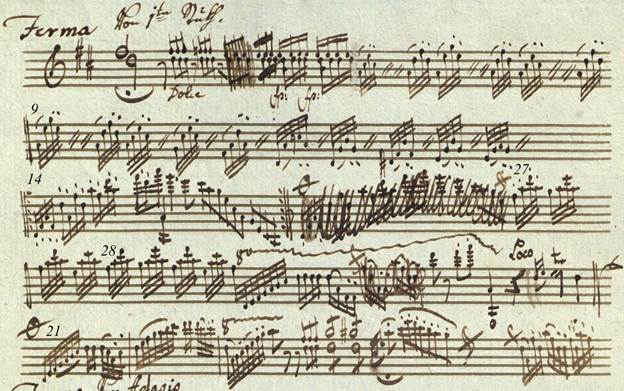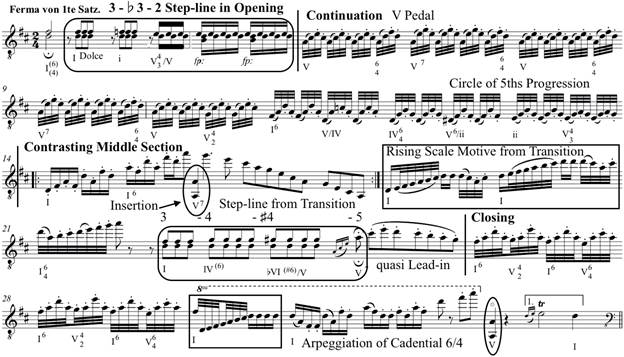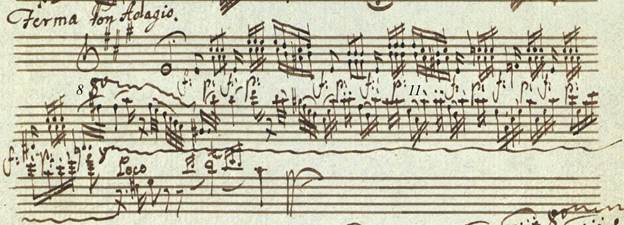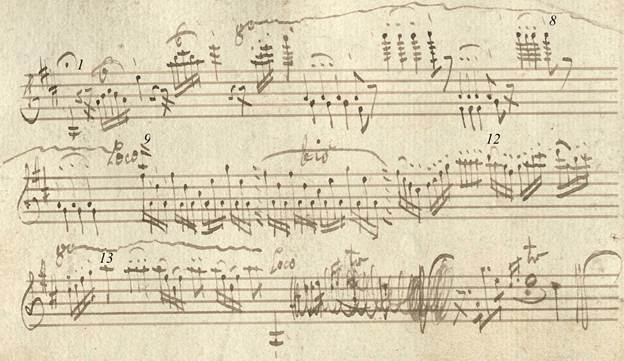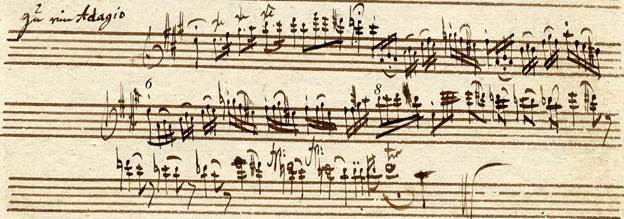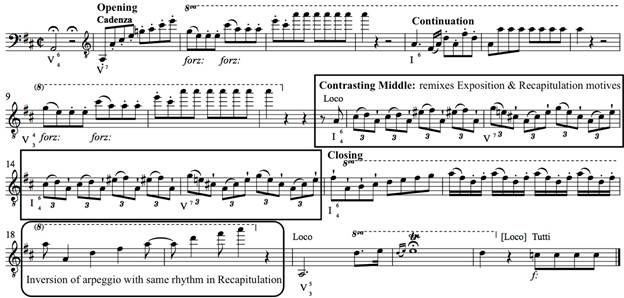Volume 13, August 2021
Sperger's Cadenzas for his Contrabass Concertos: A Study of Compositional Techniques and Improvisational Strategies for Creating Cadenzas
by Renaud Boucher-Browning
2. Tracing Sperger's Creative Process

The manuscripts presented in this section are located at the Landesbibliothek Mecklenburg-Vorpommern Günther Uecker in Schwerin, Germany (hereafter D-SWI) and are labeled with the prefix 'Mus' and the shelf number. The numbering of Sperger's eighteen contrabass concertos follows the order and chronology given in Adolf Meier's catalogue.29 In the transcriptions of Sperger's manuscript cadenzas, the bass part is notated in the register in which it appears in the original text, which Sperger notated in treble clef an octave higher than modern practice. In the transcriptions, treble clefs with an octava bassa sign are a reminder to readers that the sounding pitch is two octaves lower than the written pitch. The transposable tuning of the fretted four- or five-string Viennese violone, labeled 'Contrabasso solo' in Sperger's concerto scores, appears in Example 2.2 with a picture in Example 2.1. For all but three of the concertos with cadenzas presented here, Sperger tuned the solo contrabass a half-step higher so that it functioned as a transposing instrument, with the solo part notated in the written keys of D and A rather than the sounding keys of E♭ and B♭.
Example 2.1. Viennese Violone in the Berlin Philharmonic Instrument Museum
Example 2.2. Transposable 4- or 5-string Viennese Tunings in D, E♭ and F.
Allegro Cadenza for Sperger's Concerto No. 2 in E♭ Major (Preßburg, 1778)30
The first-movement cadenza for Concerto No. 2 contains three possible options of different durations. Shown in Examples 2.3 and 2.4, this cadenza contains both a specific thematic quotation from the movement and generic figurations like the ascending waveform scale that reappear in later cadenzas. As his opening gambit, Sperger quotes one bar of the primary theme and repeats it twice in sequence by descending third using the model-sequence technique. This sequence echoes the I-vi-IV progression in the tutti transition before the cadenza fermatas. In the continuation, Sperger implements the motivic-development schema with an arpeggiation of V7564 in bars 4-5, a stock formula that reappears with slight variations in the opening of the third cadenza on the cadenza page for Concerto No. 12 in Example 2.34 and in Sperger's cadenza for the first movement of Vanhal's concerto. The development of the V7564 arpeggiation rises to the high register, where Sperger employs the motivic-development schema again to spin out an upper-voice dominant pedal pattern. A feint via V43/IV moves to V/ii, before circle-of-fifths motion through ii and V leads to the first ending trill. This first version is the shortest option.
In the second version, this now false first ending trill ushers in an ascending waveform scale that peaks with four arpeggiations of the cadential six-four chord before a second closing trill. The third version continues from the high A before the first trill to a scale outlining V7, although the same continuation could be inserted after the high A in the penultimate bar of the second version, thus connecting all three versions in the order Sperger wrote them. The roman numeral analysis below the reduction in Example 2.5 shows Sperger's use of sequential transposition by descending third in bars 1-3 and bar 11, a dominant pedal point in the upper voice in bars 9-10, and a five-bar circle of fifths progression in bars 12-16 that spans the false first ending trill.
Example 2.3. Sperger, cadenza for I. Allegro moderato from Concerto No. 2 (m. 192), Mus 5872/4, L 2i.
Example 2.4. Transcription and harmonic analysis of cadenza for I. Allegro moderato from Concerto No. 2.
Example 2.5. Harmonic reduction of cadenza for I. Allegro moderato from Concerto No. 2.
 The three options on this cadenza page provide a glimpse into Sperger's creative process. There are scratched-out notes between bars 6 and 7. The bar line after the first ending trill with fermata resembles a final bar line, while the downbeat of bar 15 appears to have started as a D before Sperger altered it to F♯. Sperger labels each of the alternate endings Anhang [Appendix]. The first ending option notably fails to reiterate the cadential six-four chord before the trill, an omission that Sperger corrects in the second ending but not in the third, which contains a scalar outline of V7. The disposition of the three options shows the order in which Sperger notated them, generating alternative endings from his reservoir of idiomatic stock formulas perhaps because he deemed the first option to be too short, determined that the second option was too long, and then compromised with the third. As the longest of the three, the second option best reflects the archetypal four-part form of Sperger's cadenzas, with the high-register dominant pedal as the contrasting middle and the waveform scale as the start of the closing section.
Adagio Cadenza for Sperger's Concerto No. 2 in E♭ Major (Preßburg, 1778)
The second-movement cadenza for Sperger's Concerto No. 2 begins with an opening gambit by quoting a double-stop progression with suspensions from the secondary theme group, as shown in the top staff of Example 2.6. This quotation is a unique instance of linear voice-leading in the middle register. The middle staff shows the secondary theme where it first appears in the movement with its original bassline, resulting in a different three-voiced harmonic progression.
Example 2.6. Sperger, II. Cantabile from Concerto No. 2, Mus 5177/6 solo part, p. 11, mm. 62-65.31
 As shown in Examples 2.7 and 2.8, the cadenza diverges from the quoted theme in the middle of the third bar, moves to the subdominant (I6-IV), and then alternates between tonic and dominant (I6-V42) before arpeggiating the tonic in sextuplets. After this high point, the cadenza diverges into two options for the contrasting middle section: an arpeggiated progression with a chromatically descending bassline or a double-stop passage. In the reduction in Example 2.9, the first ending progression in the top staff implies deceptive motion, with V7/IV resolving ambiguously to a scalar outline of ii64, while the second ending progression in the bottom staff arpeggiates vii°7/V before implying V97 with a double-stop scale in thirds. Both closing sections conclude the cadenza with arpeggiations of the tonic in successively higher inversions with an echo effect before the final trill. This echo results from pp dynamic markings in the first ending and a restatement of the arpeggio figuration one octave lower in the second ending. This cadenza shows Sperger's ability to craft endings with different figurations and harmonic trajectories.
Example 2.7. Sperger, Cadenza Network for II. Cantabile from Concerto No. 2 (m. 88), Mus 5872/4, L 2i.
Example 2.8. Transcription and Harmonic Analysis of Cadenza Network for II. Adagio from Concerto No. 2.
Example 2.9. Harmonic Reduction of Cadenza Network for II. Adagio from Concerto No. 2.
Adagio Cadenzas from the Solo Part of Zimmermann's Concerto No. 1 (Preßburg, c1778)
Anton Zimmermann (1741-1781), concertmaster of the Preßburg court orchestra where Sperger worked from 1777 to 1783, composed his first contrabass concerto for Sperger and his second for their colleague Josef Kämpfer (1737-after 1797).32 Sperger's estate holds the score and parts for the first concerto, including an unnumbered page in the solo part with three cadenzas on the front and a score fragment from another concerto on the back.33 Radoslav Šašina and Edicson Ruiz include the Allegro cadenza on this insert in their recordings of this concerto, but they follow Sperger's cut omitting the cadenza from the Andante in Example 2.10.34 This Andante is in G major, but the insert contains two Adagio cadenzas in A major, indicating that Sperger probably composed the cadenzas on the insert for another concerto.35 Sperger may have inserted this cadenza page into the solo part of Zimmermann's first concerto because the Allegro cadenza fit the character of the first movement; this suggests that Sperger transferred cadenza pages between concertos, with their current placement linked to the last time Sperger used them.
Example 2.10. Sperger, Cut in II. Andante from Zimmermann's Concerto No. 1, Mus 5817 solo part, p. 11.
 The short Adagio cadenza from this insert appears in Examples 2.11, 2.12, and 2.13, while the long Adagio cadenza appears in Examples 2.14, 2.15, and 2.16. The short cadenza begins with vii°7/V, a harmony that figures prominently in the Allegro cadenza for Concerto No. 736 and opens the short Adagio cadenza for Concerto No. 8 in Example 2.25. The thirty-second note pattern in the short cadenza is a stock figuration that recurs in Sperger's Finale cadenza for Vanhal's Concerto.37 The long cadenza's opening outline of V7 returns in the cadenza in Example 2.44 with turns instead of grace notes. The continuation of the second cadenza features the open F♯ string in a pedal point on V/ii that reappears in the cadenza in Example 2.31, while the contrasting middle is a bariolage progression in the parallel minor with a sol-le-sol-fi-sol or 5-♭6-5-♯4-5 bassline. The closing tonicizes IV with a variant of the chromatic neighbor tone figuration that ends the Allegro cadenza for Sperger's Concerto No. 7 in A major (1781).
Example 2.11. Sperger, Short Adagio cadenza on insert in Zimmermann Concerto No. 1, Mus 5817 solo part.
Example 2.12. Sperger, Short Adagio cadenza on insert in Zimmermann Concerto No. 1, Mus 5817 solo part.
Example 2.13. Reduction of Short Adagio cadenza from Zimmermann Concerto No. 1, Mus 5817 solo part.
Example 2.14. Sperger, Long Adagio cadenza on insert in Zimmermann Concerto No. 1, Mus 5817 solo part.
Example 2.15. Sperger, Long Adagio cadenza on insert in Zimmermann Concerto No. 1, Mus 5817 solo part.
Example 2.16. Reduction of Long Adagio cadenza from Zimmermann Concerto No. 1, Mus 5817 solo part.
Allegro Cadenza for Sperger's Concerto No. 8 in E♭ Major (Kofidisch, 1783)
The first movement cadenza for Concerto No. 8 occurs after a ten-bar tutti transition containing a rising scale motive repeated in sequence by descending third, as shown with boxes in Example 2.17. The following bassline contains a step-line from scale degrees 4-♯4-5. In two examples of motivic citation, the rising scale motive and the 4-♯4-5 step-line appear in Sperger's cadenza for this movement, but the sequence by descending third is conspicuously absent.
Example 2.17. Sperger, pre-cadenza tutti in I. Allegro majestoso in Concerto No. 8, Mus 5177/4 solo pt., p. 9.
 The Allegro cadenza from Concerto No. 8 in Example 2.18 opens with a descending chromatic step-line (3-♭3-2) over a tonic pedal that continues with a virtuosic bariolage passage over a dominant pedal. Sperger departs from the dominant pedal with a three-voice progression in the low register, where the frets of the Viennese violone render triadic patterns idiomatic. The ensuing repeated stock arpeggiation of I and V7 in the contrasting middle section contains a virtuosic leap down to an octave double-stop on A. Judging from the note spacing in the first iteration and the absence of the double-stop from the scribbled-out second iteration, Sperger evidently added the low double-stop after creating the initial version. This added virtuosity capitalizes on the range of the bass for comic effect while also furnishing a sonorous dominant pedal tone beneath the arching arpeggiated figuration, thereby sustaining the harmonic tension.
In this cadenza, Sperger uses symbols not to show alternative options but rather to replace erased sections in the body of the cadenza with new material from the bottom staff of the manuscript shown in Example 2.18. The first insertion contains two repetitions of a decorated version of the rising scale motive from the tutti transition, followed by the scale degree (3)-4-♯4-5 step-line from the transition in double-stops over a tonic pedal leading to a fermata on V. A group of seven eighth notes leads to a new figuration made up of parallel sixths oscillating around a dominant pedal in the middle voice, signaling the start of the closing section. The rising scale motive makes one last appearance before the closing arpeggiation of the cadential six-four chord, a low double-stop on the dominant, and the ending trill. Like the first movement cadenzas from the solo part of Concerto No. 12 in Example 2.34, this cadenza has an engaging narrative structure, alternating between dolce lyricism and dramatic virtuosity while juxtaposing the ethereal flageolet tones of high harmonics with the earthy depths of low multiple-stops. The second ending shows a chromatic ascent to a trill that appears at the bottom of this cadenza page. The slurs in Example 2.20 show melodic step-lines and conjunct motion in the bassline of this cadenza, which exemplifies several of Sperger's idiomatic figurations for the Viennese violone.
Example 2.18. Sperger, cadenza for I. Allegro majestoso from Concerto No. 8, Mus 5872/4, L 3b.
Example 2.19. Transcription of cadenza for I. Allegro majestoso from Concerto No. 8, Mus 5872/4, L 3b.
Example 2.20. Harmonic reduction of cadenza for I. Allegro majestoso in Concerto No. 8, Mus 5872/4, L 3b.
Adagio Cadenzas for Sperger's Concerto No. 8 in E♭ Major (Kofidisch, 1783)
The cadenza fermata in the Andante poco Adagio from Concerto No. 8 follows a six-bar tutti transition ending with scale degrees 2-3-4-♯4-5 in the bass line, as shown in Example 2.21. In his two cadenzas for this movement, Sperger uses descending chromatic bass lines that refute this ascent. After dramatically arriving at the fermata, the long cadenza in Examples 2.22 and 2.23 begins with double-stop figurations over a dominant pedal before embarking on a le-sol-fi-fa progression that descends unexpectedly through scale degrees ♭6-5-♯4 to ♮4, not 5. Marked by a two-octave leap into the upper register, the contrasting middle section contains a sequence by descending fifth followed by alternation from I6 to IV with scale degrees 3 and 4 in the bass. After the closing arpeggiates V64, scale degrees ♯4-5 reappear, resolving the harmonic tension.
The bass line of Sperger's short cadenza for this movement also descends through scale degrees 5-♯4-♮4-3, reversing the ascent to the fermata before arpeggiating the cadential six-four chord. The slurs below the reductions in Examples 2.24 and 2.27 show the chromatic bass lines in both cadenzas. The first and second movement cadenzas for Concerto No. 8 show Sperger's use of conjunct chromatic motion in the melody and bassline to imply progressions that depart from and return to V64 or V7, creating an arc of tension and release within each cadenza.
Example 2.21. Pre-cadenza tutti in II. Andante poco Adagio from Concerto No. 8, Mus 5177/4 solo part, p. 9.
Example 2.22. Sperger, long cadenza for II. Andante poco Adagio from Concerto No. 8, Mus 5872/4, L 3b.
Example 2.23. Transcription, long cadenza for Andante poco Adagio from Concerto No. 8, Mus 5872/4, L 3b.
Example 2.24. Reduction of long cadenza for II. Andante poco Adagio from Concerto No. 8.
Example 2.25. Sperger, short cadenza for Andante poco Adagio, Concerto No. 8, Mus 5177/4 solo part, p. 16.
Example 2.26. Transcription of short cadenza for II. Andante poco Adagio from Concerto No. 8.
Example 2.27. Harmonic reduction of short cadenza for II. Andante poco Adagio from Concerto No. 8.
Allegro Cadenza for Sperger's Concerto No. 10 in E♭ Major (Berlin, 1787)
The first-movement cadenza for Concerto No. 10 in Example 2.28 and 2.29 consists of figurations that reappear with variations in the cadenzas for Concertos Nos. 12 and 16; this attests to Sperger's iterative embellishment of stock formulas. The opening sextuplet gestures and the continuation double-stops combine to create the opening of the cadenza for No. 16. The implied triple meter in the opening section of the cadenza for No. 10 creates metric ambiguity that resolves only after the first set of double-stops returns to cut time. The alternation between scale degrees 4 and 3 (G and F♯) in the lower voice of the double-stops presages similar voice-leading in passagework in the cadenzas for No. 12. The leaps between registers in this continuation exemplify Sperger's use of call and response to imply different characters. The sudden change to sixteenth notes in bar 9 signals the contrasting middle, which leads to the closing ascent. The dominant pedal pattern in the contrasting middle, the closing waveform scale interrupted by a repeated scale degree 5, and the scalar V64 each return in different cadenzas for Concerto No. 12. The crossed-out flourish and trill in the first ending contain scale degrees 1-2-3-2-1, while the second ending outlines V7, creating a 4-3-2-1 step-line. The reduction in Example 2.30 shows that this cadenza is primarily a prolonged dominant pedal point.
Example 2.28. Sperger, cadenza for I. Moderato from Concerto No. 10, Mus 5177/1 solo part, p. 18.
Example 2.29. Transcription of cadenza for I. Moderato from Concerto No. 10, Mus 5177/1 solo part, p. 18.
Example 2.30. Harmonic reduction of cadenza for I. Moderato from Concerto No. 10, Mus 5177/1, p. 18.
Adagio Cadenza for Hoffmeister's Concerto No. 3 in E♭ Major (Vienna, c1786-1789)
Of Franz Anton Hoffmeister's three contrabass concertos, Concerto No. 3 is the only one in Sperger's estate and the only one with his cadenzas.38 In his cadenza page for this concerto, Sperger uses symbols along with instructions to create a network of several possible Adagio cadenzas, given in Examples 2.31 and 2.32 with a reduction in 2.33. These options result from two possible openings and an internal cut. Taking the cut from bar 46 to bar 54 or the alternative opening in bar 69 approximately halves the total length. Sperger also scribbled out the original ending and replaced it with a longer alternative. This evidence suggests that Sperger started this virtuosic cadenza with an abundance of ideas that he later abridged to meet his expectations for cadenza length during his concert tours in search of employment from 1786 to 1789.39
Both openings for the cadenza in Example 2.31 are variants on the scalar outline of V7 in the long Adagio cadenza from Zimmermann's Concerto No. 1 in Example 2.14. The original continuation of the Hoffmeister Adagio cadenza is a sixteenth-note variation of the pedal point on V/ii in eighth notes from Example 2.14. The two-octave arpeggios of I and vii°6 in the contrasting middle are unique to this cadenza, but the ensuing tonic prolongation is in the Adagio cadenza for Sperger's Concerto No. 2 in Example 2.7. After these sextuplet tonic arpeggios, Sperger closes with a leaping figuration in harmonics that teasingly alternates between I and IV before moving to a scalar outline of V64. After a sextuplet variation on the tonic prolongation figure, the alternative opening reconnects at the tonic arpeggiation. This Adagio cadenza draws on figurations from earlier cadenzas and highlights Sperger's use of stock formulas to invent new cadenzas. In its original form, this Adagio cadenza is the longest of its kind in Sperger's output.
Example 2.31. Sperger, Cadenza for II. Adagio from Hoffmeister's Concerto No. 3, Mus 2850 solo part insert.
Example 2.32. Sperger, Cadenza for II. Adagio from Hoffmeister's Concerto No. 3, Mus 2850 solo part insert.
Example 2.33. Harmonic reduction of cadenza for II. Adagio from Hoffmeister's Concerto No. 3, Mus 2850.
Allegro Cadenzas for Sperger's Concerto No. 12 in E♭ Major (Ludwigslust, c1792)
The solo part for Sperger's Concerto No. 12 includes a double-sided page with five cadenzas. The front holds the three first-movement cadenzas in Example 2.34 and the second-movement cadenza in Example 2.44, while the back holds the first-movement cadenza network in Example 2.41. These cadenzas show several improvisatory aspects of Sperger's creative process. Sperger employs recurring stock formulas in multiple cadenzas, either interwoven with quotes from the concerto or varied with embellishments. In the cadenza network, he uses symbols that map out several possible realizations given the same start and endpoints. This page from the solo part of Concerto No. 12 may indicate that Sperger drafted several cadenzas for one concerto and/or that he collected cadenzas for several concertos on one page; the metric mismatch between the triple-meter Adagio cadenza and the duple-meter Andante in Concerto No. 12 supports the latter.
One of the first-movement cadenzas and the second-movement cadenza contain stock figurations that also appear in the corresponding cadenzas for the Vanhal concerto (c.1786-1789, Vienna).40 This time period encompasses the completion dates of Sperger's Concertos No. 9 (1785-1786, Kofidisch and 1786-1787, Vienna) and No. 10 (1787, Berlin).41 The starting half notes, ending trills, and quadruple meter in two of the first-page cadenzas match the common-time first movement of Concerto No. 9.42 In addition, the non-trill ending of the cadenza network matches the half rest under the second cadenza fermata in the solo part of Concerto No. 15 (1796).43 This collection may therefore contain the accumulation of Sperger's improvisatory ideas for several of the concertos that he composed in the years after Concerto No. 8 (1783) and before Concerto No. 16 (1797), which each have a page with embellishments for all fermatas.
Of the three first-movement cadenzas in D major in Example 2.34, only the short middle cadenza quotes directly from the Allegro moderato in Concerto No. 12. Sperger labels the other two longer cadenzas No. 1 and No. 2, respectively, with oder [or] and oder Dieße [or this one] linking the three cadenzas. This disposition presents each cadenza as an alternative to the others, supported by contrasts in content and differences in length that suggest that each cadenza could be for separate performances of the same concerto or even for a series of several concertos. The distinctive elements of the two longer cadenzas fit into the four-part form of Sperger's cadenzas.
Example 2.34. Sperger, Cadenzas for I. Allegro moderato from Concerto No. 12, Mus 5176/7 solo part, p. 17.
The opening of the first cadenza in Example 2.35 employs double-stops to alternate between V64 and V7, while the continuation arpeggiates V7 in an arcing gesture. The contrasting middle section begins with two beats of closing figuration from the recapitulation of the first movement of Concerto No. 12, but then diverges into the opening figuration from the short cadenza and the cadenza network in diminution. The closing section ascends through scalar and arpeggiated forms of V64. The Arabic numerals above the staff in the reduction in Example 2.36 show the alternation between scale degrees 3 and 4 (F♯ and G) in the upper or lower voice throughout.
Example 2.35. Sperger, 1st Cadenza for I. Allegro moderato in Concerto No. 12, Mus 5176/7 solo part, p. 17.
Example 2.36. Harmonic Reduction of 1st Cadenza for I. Allegro moderato in Concerto No. 12.
The short cadenza in Example 2.37 and the cadenza network in Example 2.42 start with fermatas over quarter-note A's in two different octaves, rather than the half-note A under the first fermata in the other cadenzas in Example 2.34. Whereas a half-note low A is usual for Sperger's cadenza fermatas in common time or alla breve first movements, these quarter-note A's reveal an inconsistency between the fermata notes in the solo part and in the cadenza page. This short cadenza reprises closing theme figuration from the first movement of Concerto No. 12 that oscillates between scale degrees 3 and 4, prolonging the 5-4-3-2-1 step-line in Example 2.38.
Example 2.37. Sperger, Short Cadenza for I. Allegro moderato in Concerto No. 12, Mus 5176/7 solo pt., p. 17.
Example 2.38. Harmonic Reduction of Short Cadenza for I. Allegro moderato from Concerto No. 12.
 The boxes in Example 2.39 show that the second cadenza for Concerto No. 12 mainly consists of figuration that also appears in the first movement cadenzas for Sperger's Concerto No. 2 and Vanhal's Concerto. The opening four bars and the waveform scale differ from the versions in the cadenza for Concerto No. 2, while the double-stop sequence in the contrasting middle has note values that are twice the length of those in the cadenza for Vanhal's concerto. The subtle differences between these similar passages in three cadenzas evince that Sperger varied stock formulas when creating generic cadenza content, to which he added quotations from specific concertos. The cadenza in Example 2.39 resembles a draft or a reworking of the Vanhal cadenza. The reduction in Example 2.40 shows Sperger's elision of a circle of fifths progression in the continuation with a descending thirds sequence in the contrasting middle.
Example 2.39. Sperger, 2nd Cadenza for I. Allegro moderato in Concerto No. 12, Mus 5176/7 solo part, p. 17.
Example 2.40. Harmonic Reduction of 2nd Cadenza for I. Allegro moderato from Concerto No. 12.
 The cadenza network in Examples 2.41 and 2.42 is unique among Sperger's cadenzas for its use of symbols to notate three possible cadenzas with the same beginning and ending. This practice anticipates Robert Levin's use of numbered options in modular cadenzas for Mozart's Violin Concertos.44 This cadenza network shares its point of departure with the short cadenza for Concerto No. 12, but the ensuing leaping minore pattern reappears an octave higher in the cadenza for Concerto No. 16. The dominant pedal pattern in bar 11, meanwhile, also appears in the first-movement cadenzas for Concerto No. 10 and Vanhal's Concerto. At this point, the network diverges into two options, each of which starts with a variant of the waveform scale. The first option starts with a dominant pedal pattern in the middle register, ascends to a repeated high A that alternates with arpeggiation of the tonic triad, and ends with high harmonics arpeggiating V64 and a progression in double-stops rather than a trill. The second option quotes bar 80 of the first movement of Vanhal's Concerto before sequencing a two-beat waveform scale interspersed with repeated notes up by perfect fourth. This sequence leads to a dominant pedal in the upper register, a brief tonicization of IV, and a scalar ascent before this option ends with a similar double-stop progression. The shorter third option stems from the interpolation in bar 8, which leads to bar 34 before returning to the middle of the second option at bar 29. Example 2.43 presents harmonic reductions of all three options. The segno symbol moves to the second option, the coda symbol jumps to the third option, and the section symbol jumps back.
Example 2.41. Sperger, Cadenza network for I. Allegro mod. in Concerto No. 12, Mus 5176/7 solo part, p. 18.
Example 2.42. Sperger, Cadenza network for I. Allegro moderato in Concerto No. 12 or No. 15 (?).
Example 2.43. Harmonic Reduction of Cadenza Network for I. Allegro moderato in Concerto No. 12/15 (?).
Adagio Cadenza from the Solo Part of Sperger's Concerto No. 12 (Ludwigslust, c1792)
The Andante con Variazioni from Concerto No. 12 is in duple meter,45 which does not match the implied triple meter of the cadenza labeled zu ein Adagio [for an Adagio] from the cadenza sheet for Concerto No. 12 in Examples 2.44 and 2.45. Moreover, the only other second movement in theme and variations form in Sperger's contrabass concertos, the Andante poco Adagio from Concerto No. 18, lacks cadenza fermatas.46 The slow movements of Concertos No. 9 and No. 10 are in the same key as the metrically mismatched cadenza in Example 2.44, with cadenza fermatas in both solo parts over the same starting note and ending trill as this mystery Adagio cadenza; the Adagio from No. 9 is in duple meter, while the Andante from No. 10 is in triple meter.47 Due to the metric mismatch with the Adagio from Concerto No. 9, this cadenza could fit in the Andante from Concerto No. 10, allowing for the difference in the tempo marking.
This cadenza opens with an ornamented scalar outline of V7, like the long Adagio cadenza from Zimmermann's Concerto No. 1 in Example 2.14 and the Adagio cadenza for Hoffmeister's Concerto No. 3 in Example 2.31. Though this cadenza lacks bar lines, the stock sixteenth-note triplet figuration in the contrasting middle section appears in Sperger's Adagio cadenza for Vanhal's concerto with bar lines in triple meter.48 The closing of this cadenza embellishes the ending of the Adagio cadenza from Vanhal's concerto by progressively augmenting the rhythm, which changes the implied meter to duple before returning to triple at the end. The reduction in Example 2.46 shows the pedal points on V/IV and V in this cadenza.
Example 2.44. Sperger, Cadenza for an Adagio [No. 9 or 10?] in Concerto No. 12, Mus 5176/7 solo part, p. 17.
Example 2.45. Transcription of Adagio cadenza [No. 9 or 10?] in Concerto No. 12, Mus 5176/7 solo pt., p. 17.
Example 2.46. Reduction of Cadenza for II. Adagio (Concerto No. 9) or II. Andante (Concerto No. 10).
Allegro Cadenza for Sperger's Concerto No. 13 in D Major (Ludwigslust, c1792)
There are two sets of fermatas labeled "Cadenza" in the first movement of Concerto No. 13, one in the recapitulation and the other in the closing ritornello. Example 2.47 shows the blank line after the fermatas in the recapitulation, which leaves space for a short embellishment before the instruction Siegue [Segue], Sperger's indication for when a passage continues on the next page. Though labeled 'Cadenza,' these fermatas at an arrival on V7 invite a transitional lead-in. The piano-forte figuration following these fermatas on the next page appears in Example 2.48.
Example 2.47. Sperger, 1st 'Cadenza' fermatas for Allegro m. in Concerto No. 13, Mus 5176/6 solo part, p. 7.
In contrast to his usual practice,49 Sperger notated the unique accompanied cadenza after the second set of fermatas in this movement directly in the solo part in Examples 2.49 and 2.50 and the score in Examples 2.53, 2.54, and 2.55, with slight differences between the sources.50 This fully metrical cadenza develops several motives from the movement by recombining them with variations in the cadenza, which demonstrates that Sperger sought to imitate an improvisatory chain of ideas even in a composed cadenza.51 Composing witty exchanges between the soloist and the winds in this cadenza freed Sperger to improvise a lead-in for the first set of fermatas.
Unlike the formulaic cadenzas for Concerto No. 12 that could fit into other concertos, the cadenza in the first movement of Concerto No. 13 derives its motives and the teasing character of its gestures from the parent movement. In the opening and the continuation, the soloist arpeggiates V7 and the cadential six-four chord in a call-and-response passage with the oboes and horns. The contrasting middle remixes the boxed triplet motive from Example 2.47 now alternating between dominant and tonic harmonies under a sustained progression in the winds. The closing section concludes with ascending arpeggiation of the cadential six-four chord that matches the boxed syncopated rhythm of a descending V7 arpeggio in the consequent phrase following the lead-in fermatas in Example 2.48. In the cadenza in the solo part, the closing trill is in the upper register, an octave higher than in the score. In the middle of this trill, the tutti string section loudly interjects on the dominant in an exaggerated parody of the tutti basso entrances notated under the cadenza fermatas in all three movements of Sperger's Concerto No. 1 (1777).52
Example 2.48. Sperger, After 1st Cadenza in I. Allegro moderato, Concerto No. 13, Mus 5176/6 solo part, p. 8.
The relative simplicity of the reduction of the solo part in Example 2.52 shows that though it only alternates between dominant and tonic in various inversions, this cadenza creates interest by juxtaposing extreme registers to create dramatic contrast, using dialogue with the orchestra to prolong harmonic tension, and gradually shortening the rhythmic subdivisions in the solo part.
Example 2.49. Sperger, cadenza for I. Allegro moderato in Concerto No. 13, Mus 5176/6 solo part, p. 8.
Example 2.50. Sperger, cadenza for I. Allegro moderato in Concerto No. 13, Mus 5176/6 solo part, p. 9.
Example 2.51. Transcription of cadenza for I. Allegro moderato in Concerto No. 13, Mus 5176/6 solo, p. 8-9.
Example 2.52. Harmonic reduction of solo part in the cadenza for I. Allegro moderato from Concerto No. 13.
Example 2.53. Accompanied cadenza in I. Allegro moderato in Concerto No. 13, Mus 5176/6 score, p. 19.
Example 2.54. Accompanied cadenza in I. Allegro moderato in Concerto No. 13, Mus 5176/6 score, p. 20.
Example 2.55. Orchestral reduction of accompanied cadenza in I. Allegro moderato in Concerto No. 13.
Allegro Cadenza for Sperger's Concerto No. 16 in E♭ Major (Ludwigslust, 1797)
In Concerto No. 16, the first-movement cadenza fermatas occur in the closing ritornello after a seven-bar tutti. Sperger notated a cadenza for the first movement and a lead-in for the second movement on both sides of a small piece of paper in Mus 5872/4, catalogued in the Fragments and Sketches section of Meier's catalogue.53 Examples 2.56 and 2.57 present the front and back sides of this page with the lead-in inserted at the start of the third line of the front side. Sperger again uses symbols to create a cadenza with two endings, as well as the word aus [over] at the end of the first page to signal the page turn. While the first ending produces a cadenza of average length, the second ending doubles the length, resulting in Sperger's longest Allegro cadenza.
The form of this double cadenza contains a false first ending, which creates a deceptive first closing section. After the transitional second opening, the second half of this cadenza duplicates the remaining three formal functions of Sperger's cadenzas. The second continuation backtracks from the arrival on the cadential six-four chord in the first closing section, leading to a second contrasting middle section with a tempo change to Andante. While an A Tempo follows the poco Andante in the opening, no such indication appears after this Andante. Given the three-bar duration of the poco Andante, the Andante likely lasts only until the middle of the second line.
Example 2.58 shows these formal sections in bold, with boxes that indicate motives from prior cadenzas for other concertos by Sperger. The opening gambit quotes a piano bell-tone motive from the recapitulation of the first movement of Concerto No. 16, followed by a feint into the parallel minor originally from a lead-in for Concerto No. 11.54 The first continuation develops the opening motive of the first-movement cadenza for Concerto No. 10, while the first contrasting middle varies the pedal pattern from the short cadenza for Concerto No. 12. The V7/IV arpeggio and chromatic neighbor tones in the second continuation come from the second cadenza for No. 12, while the glissando figure in the second contrasting middle is from the cadenza network for No. 12. As in the cadenza for No. 13, the subdivisions progress from eighths to triplets to sixteenths.
The second half of this cadenza showcases Sperger's novel combinations of stock devices in his late cadenza style. The registral jumps in bars 41-42 create a call and response effect, while the closing scalar ascent employs double-stop thirds to imply the imitative entry of a second voice. Example 2.59 gives the harmonic reduction of this double cadenza for Concerto No. 16. While the first half alternates solely between tonic and dominant harmonies, the second half employs modal mixture in the glissando passage to imply iiø7 and then tonicizes IV and V. These secondary dominants embellish the progression IV-iiø7-V-(I), creating a greater sense of closure.
Example 2.56. Sperger, Allegro cadenza and Adagio lead-in for Concerto No. 16, Mus 5872/4, L 2n, front.
Example 2.57. Sperger, Allegro cadenza for Concerto No. 16 continued, Mus 5872/4, L 2n, back.
Example 2.58. Transcription of cadenza for I. Allegro moderato from Concerto No. 16, Mus 5872/4, L 2n.
Example 2.59. Harmonic reduction of cadenza for I. Allegro moderato from Concerto No. 16.
|


















